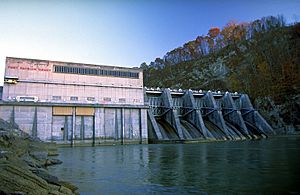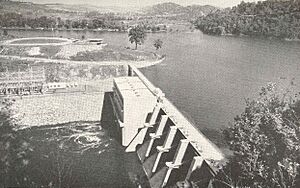Fort Patrick Henry Dam facts for kids
Quick facts for kids Fort Patrick Henry Dam |
|
|---|---|

Fort Patrick Henry Dam
|
|
| Official name | Fort Patrick Henry Dam |
| Location | Kingsport, Tennessee, United States |
| Coordinates | 36°29′52″N 82°30′30″W / 36.49778°N 82.50833°W |
| Construction began | May 14, 1951 |
| Opening date | October 27, 1953 |
| Operator(s) | Tennessee Valley Authority |
| Dam and spillways | |
| Impounds | South Fork Holston River |
| Height | 95 feet (29 m) |
| Length | 737 feet (225 m) |
| Reservoir | |
| Creates | Fort Patrick Henry Lake |
The Fort Patrick Henry Dam is a large structure that creates electricity from water. It is located on the South Fork Holston River in Kingsport, Tennessee. This dam is in Sullivan County, Tennessee, in the United States.
The Tennessee Valley Authority (TVA) owns and runs this dam. TVA is a government agency that manages rivers and provides power. Fort Patrick Henry Dam is the lowest of three dams TVA built on the South Fork Holston River. It was built in the early 1950s. The dam helps control the river's flow. It also uses the water's power to make electricity.
The dam creates a lake called Fort Patrick Henry Lake, which covers about 872 acres. Even though it was first built for power, the dam now also helps control water flow and temperature. This is important for factories downstream. In 2017, the dam was added to the National Register of Historic Places. This means it is an important historical site.
The dam is named after a fort from the American Revolutionary War. This old fort was once near the Long Island of the Holston.
Where is Fort Patrick Henry Dam?
Fort Patrick Henry Dam is about 8 miles upstream from where the South Fork Holston River meets the North Fork Holston River. These two rivers join to form the main Holston River.
The city of Kingsport, Tennessee is just northwest of the dam. The community of Colonial Heights, Tennessee is also nearby. Part of Fort Patrick Henry Lake's shoreline is within Warriors' Path State Park. The dam is about 44 miles upstream from the John Sevier Fossil Plant. It is also about 98 miles upstream from Cherokee Dam. Both of these are on the main Holston River.
How Big is Fort Patrick Henry Dam?
Fort Patrick Henry Dam is a concrete gravity-type dam. This means it uses its own weight to hold back the water. The dam is 95 feet high and 737 feet long. It can produce 59,400 kilowatts of electricity.
The dam has a spillway with five gates. These gates can release a lot of water, up to 141,000 cubic feet per second. Fort Patrick Henry Lake stretches about 10.3 miles upstream to Boone Dam. The lake has about 37 miles of shoreline. This dam is not used to store water for flood control.
Building Fort Patrick Henry Dam
People knew that the South Fork Holston River could make electricity even in the early 1900s. The Watauga Power Company built Wilbur Dam in 1912 on a nearby river. In the 1920s, another company planned to build four dams on the South Fork Holston. They wanted to sell the electricity to nearby cities.
Around the same time, the United States Army Corps of Engineers suggested building a dam. This dam would be about a mile downstream from where Fort Patrick Henry Dam is now. When the Tennessee Valley Authority (TVA) took over flood control in the 1930s, they found a better spot for the dam. They called it the "Wexler Bend site."
TVA had already built Watauga Dam and South Holston Dam. They were also planning to build Boone Dam in 1950. These dams would control the river's flow. This made it possible to build another dam downstream to make electricity. Work on Fort Patrick Henry Dam started on May 14, 1951.
Building the dam and its lake meant buying 1,470 acres of land. About 167 acres of land had to be cleared. Twenty-two families had to move their homes. About 2 miles of roads also had to be moved. One new bridge was built. The dam was finished, and its gates were closed on October 27, 1953. The first generator started making power on December 5, 1953. The second generator began on February 22, 1954. The whole project cost $12.3 million.


